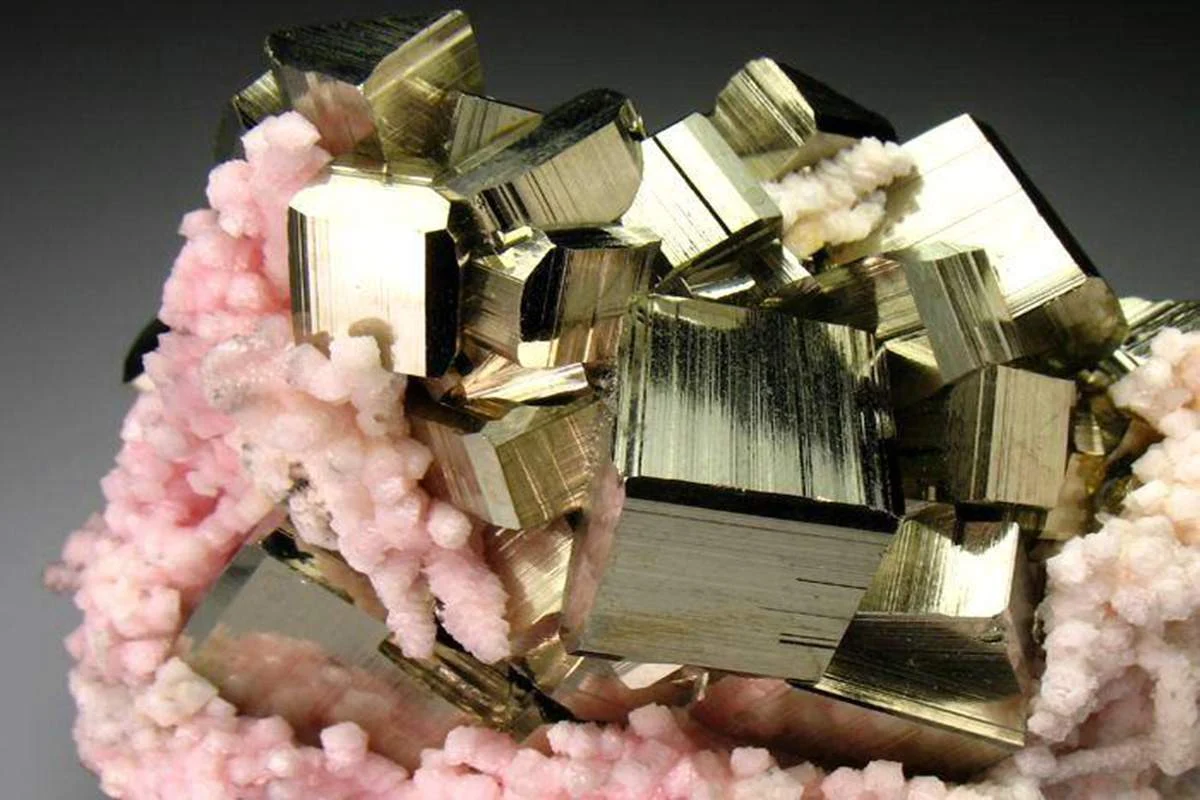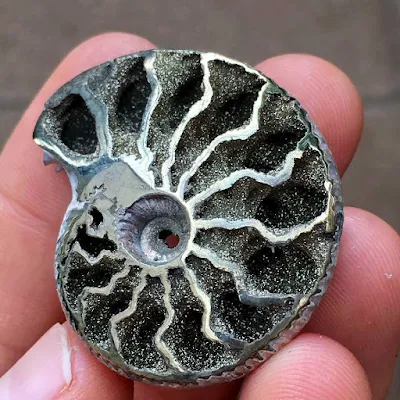Pyrite: Facts About Pyrite "Fool's Gold"
Pyrite, often nicknamed "fool's gold" for its deceptive resemblance to the precious metal, is a fascinating mineral with a rich history and practical uses. Chemically known as iron sulfide (FeS₂), it's the most abundant sulfide mineral on Earth.
Pyrite is sometimes called "Fools Gold" because of its similarity in color and shape to Gold. In the old mining days, Pyrite was sometimes mistaken for Gold, as they frequently occur together.
Crystallography: Pyrite exhibits interesting crystallographic features, including perfect cubic symmetry and often forming intricate crystal formations. This makes it a favorite among mineral collectors and enthusiasts.
Pyrite has the same chemical formula as the rarer mineral Marcasite, but it crystallizes in a different crystal system, thereby classifying it as a separate mineral species.
 |
| Pyrite:
Fool's Gold. Cubic Crystals of Pyrite Nestled Within a Matrix of
Rhodochrosite. From Cassandra Mines,macedonia Dept, Greece Credit: Crystalclassics.co.uk |
Pyrite is usually found associated with other sulfides or oxides in quartz veins, sedimentary rock, and metamorphic rock, as well as in coal beds and as a replacement mineral in fossils, but has also been identified in the sclerites of scaly-foot gastropods.
True Companion: Despite the nickname, pyrite is often found alongside real gold deposits. In some cases, the pyrite itself may even contain trace amounts of gold worth extracting.
Pyrite is quite easy to distinguish from gold: pyrite is much lighter, but harder than gold and cannot be scratched with a fingernail or pocket knife.
Pyritization: Organisms may become pyritized when they are in marine sediments saturated with iron sulfides. As organic matter decays it releases sulfide which reacts with dissolved iron in the surrounding waters. Pyrite replaces carbonate shell material due to an undersaturation of carbonate in the surrounding waters.
 |
| Two intergrown cubes of pyrite. from Navajún, La Rioja, Spain Photo Mardani Fine Minerals |
Sparkling History: The name "pyrite" comes from the Greek word "pyr" meaning "fire." This refers to its ability to create sparks when struck against metal, a property used by early humans to start fires.
Hardness Matters: Don't be fooled by its shiny look - pyrite is quite brittle. Unlike gold, it will shatter if struck with a hammer. Scratching it can also reveal its greenish-black streak, another way to tell it apart from gold.
 |
| Large Size Natural Pyritized Ammonite Fossils from Russia. Their Chambers are filled with druzy Pyrite!! Photo credit: Daniel Virgadaula |
Tarnishing: Pyrite is susceptible to tarnishing when exposed to air and moisture. Over time, pyrite specimens may develop a coating of iron oxide (rust) on their surfaces, altering their appearance.
Abundant and Common: Pyrite is actually the most abundant sulfide mineral on Earth. It can be found in a variety of geological formations around the world.
 |
| Pyritized ammonite. From Saratov Russia. Upper Callovian (around 162 million years). Photo: Leah Luten |
Space Rock: Pyrite has been found in meteorites that have fallen to Earth. This suggests that pyrite may be common throughout our solar system and perhaps even beyond.
These facts highlight the unique characteristics and historical significance of pyrite, making it an intriguing mineral for both scientists and enthusiasts alike.




%20(1).webp)



